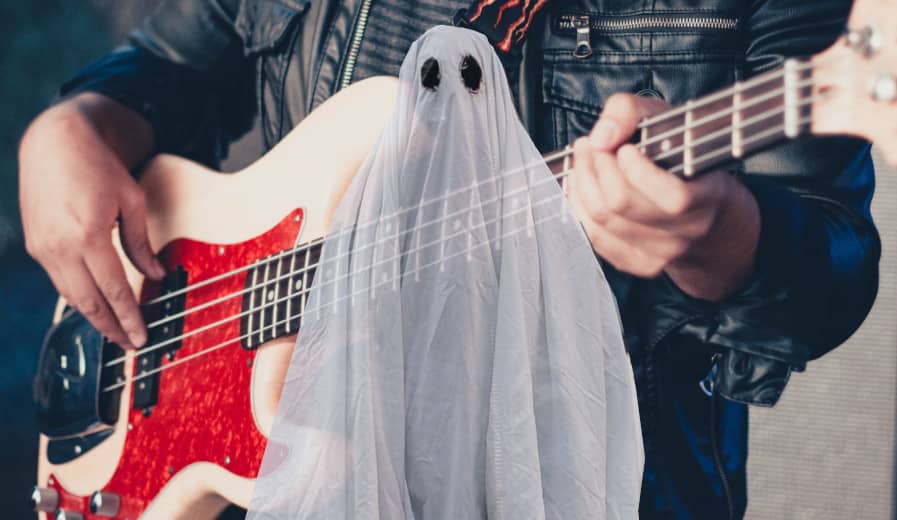Ghost notes are oftentimes what elevate bass lines from decent to great. Learning how to play them, can thus make your bass playing sound more dynamic, rhythmic, and groovy.
In this article, I will teach you how to do just that. First, let`s start by defining what a ghost note is.
On the bass guitar, ghost notes are notes that are played muted or muffled with no sustain. In general, ghost notes are played quickly before melodic notes at either an 8th or 16th note speed. They can thus be used to add rhythm and groove to a bass line without disrupting the melody.
This technique is therefore often used as a percussive effect, rather than a melodic one. This is due to the note`s short duration, as well as it not needing to ring out at a specific pitch.
I will show you how to make the most of ghost notes, by first showing you how to play them. Then, I`ve made a simple exercise that you can use to practice the technique.
Afterward, I`ll show you several versions of a bass line where ghost notes are used in different ways. . Lastly, I`ve made a list of songs that make use of ghost notes to provide some inspiration and ideas.
Playing ghost notes
How well you are able to play ghost notes largely comes down to how well you keep strings muted and avoid playing harmonics.
You can use both your hands to achieve this. Let`s start by going over how to use your fretting hand.
Fretting hand technique
When playing ghost notes, avoid touching strings right above the frets. If you do this, your bass will oftentimes produce a harmonic. As harmonics ring out and have a bright sound they produce the opposite effect of what you are looking for in a ghost note.
Instead, press the string halfway down slightly away from the fret. Pressing it halfway is important, as fully fretting it results in a normal bass note. Only gently touching the string results in a harmonic even when not holding your finger directly over the fret.
This can be difficult at first, as your muscle memory will make you want to fully fret strings. To help with this, you can use your other fingers to mute the string further.
For example, let`s say you attempt playing a ghost note by fretting a string halfway down with your middle finger. What you can do then, is to gently bring your ring and little finger down to mute the string.
In order to do this, you need to be somewhat quick, and only gently touch the string with the assisting finger. However, this is a helpful method if you are struggling with notes ringing out.
Plucking hand technique
You can also use your plucking hand to assist with muting strings when playing ghost notes. After plucking the string, you can use another finger, your thumb, or your palm to quickly mute the string.
If you play with your fingers, you can pluck a ghost note with your index finger. Then, bring your middle finger down against the string to quickly mute it. If you play with a floating thumb you can also use your thumb to mute the string, though I find this to be a less beginner-friendly method.
If you play with a pick you can use the palm of your hand to mute the string as detailed in my guide on how to hold a bass pick. Using your palm is also a great way to mute strings when slapping ghost notes.
A less used thrid alternative is to play ghost notes like you were using a pick, but without actually using one. To learn more, check out my article on chucking for bass players.
Ghost note bass exercises
One of my favorite exercises for ghost notes is to gradually include them into a simple bass line. This exercise is suitable for all skill levels as it allows you to go at your own speed. Furthermore, as you improve you can continue to use this exercise by speeding up and using different rhythms.
Let`s start with a simple bass line, that just consists of a C. Play this line at a speed you find comfortable. 100-120 BPM will generally be a good starting point.
Note: Ghost notes are indicated with an “X” in both bass tabs and notation.
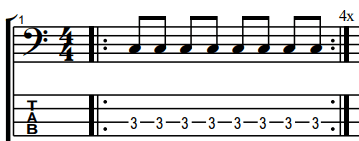
Now, let`s start by adding one ghost note to the start of the bass line. Make sure that you are able to properly mute it consistently and comfortably before moving to the other exercises.
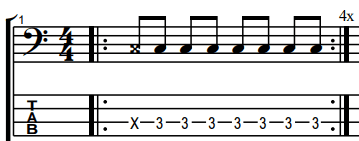
After mastering the single note, you can start adding a couple more ghost notes.
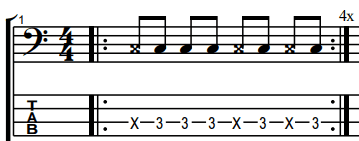
Following this, make the ghost note the sole focus of the line, only playing the C intermittently.
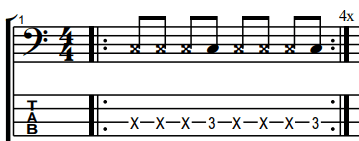
Lastly, switch to solely playing ghost notes. You might even find that playing just ghost notes can be easier than switching between them and regular notes.
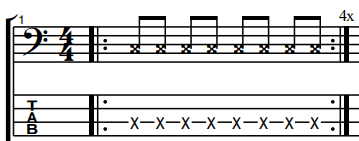
I recommend sticking to this exercise for a while if you are looking to master ghost notes. It`s great for developing your control, and it allows you to always be challenged without being overwhelmed as you can always adjust the difficulty.
How to add ghost notes to bass lines
To better understand how to make use of ghost notes, let`s take a look at an example bass line. I will present 4 stages of it, with ghost notes gradually being added to it.
First, let`s listen to the bass line without any ghost notes.

This groove does the job. However, there is little that`s special about it. Now, let`s try adding ghost notes in the place of the rests and listen to how it sounds.

Notice how the “feel” of the rest is still there. The ghost notes do not change which notes are emphasized. Instead, they add punch to the existing notes by making them sound more lively and funky.
But there are other ways to add ghost notes than to replace rests with them. We can also substitute notes in the melody.
This leads to a more drastic change in the bass line. However, when used in clever and fitting spots, they can make a groove significantly more interesting.

Notice how adding ghost notes in place of rests added to the line, whereas the above method fundamentally changed the groove.
This can be taken a step further. Instead of changing single notes to ghost notes, we can change a string of them.

The result of this is a completely different bass line. This makes it more difficult to do this well but can make a song as a whole a lot more dynamic when used in the right spots.
Situations, where you might opt for a similar line as the example above, are during short build-ups, transitions, or during a short guitar lick.
Songs with ghost notes in the bass line
The above examples are helpful for understanding in what situations you can add ghost notes. However, to fully understand how this works in songs, it can be helpful to listen to some of the greats.
Furthermore, it`s beneficial to listen to bassists in various genres. This is because ghost notes have been used in everything from Flea`s best bass lines in RHCP to sound funky, to Marcus Miller`s jazzy solo work for a melancholy and smooth sound.
With that, here is a list of 11 songs with ghost notes in the bass line from a wide range of genres and styles:
| Band | Bass Player | Bass Line With Ghost Notes |
| Marcus Miller (Solo) | Marcus Miller | Detroit |
| Rush | Geddy Lee | Free Will |
| Tower Of Power | Rocco Prestia | So I Got to Groove |
| Tool | Paul D’Amour | Sober |
| Vulfpeck | Joe Dart | My First Car |
| Jaco Pastorius (Solo) | Jaco Pastorius | Come On, Come Over |
| Pixies | Kim Deal | Hey |
| Yes | Chris Squire | Roundabout |
| Red Hot Chili Peppers | Flea | Charlie |
| The Police | Sting | Roxanne |
| Jamiroquai | Stuart Zender | Virtual Insanity |
I especially want to highlight Joe Dart`s line on My First Car. Dart is a bass player who has made ghost notes a major part of his style and used them in creative and unconventional ways.
Thus, I recommend checking this song to get a clear idea of how potent ghost notes can sound when they are used to their fullest:
Conclusion
As you can tell by now, ghost notes are a great way to elevate your bass playing regardless of what genre of music you like.
The technique impacts the overall sound of a song. It gives bassists a new way to lock in with the drummer. It also adds funkiness and groove while helping the bass become more noticeable in the mix.
By practicing muting strings and not letting harmonics ring out, you will be able to play basic ghost notes consistently in no time.
Then, using the exercises above, you can start becoming more comfortable with using the technique in real bass lines. Lastly, with all of the examples above, you will have a great starting point for writing ghost notes into more complex bass lines.
If you follow this recipe, you will be well on your way to sounding funkier, tighter, and more rhythmic in your bass playing.

